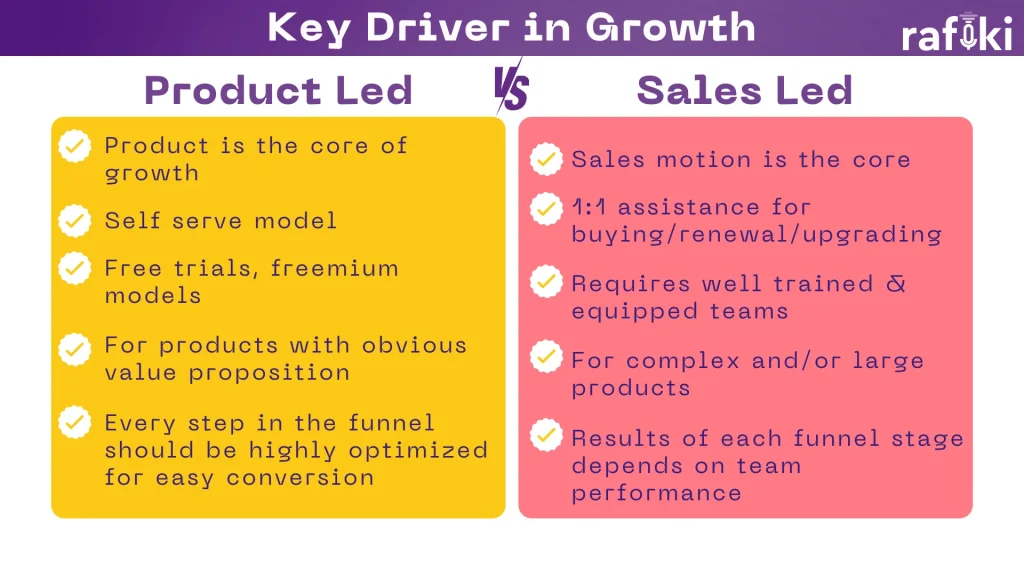Why Rafiki
Pricing


Pricing
Solutions

RevOps Leaders
Synchronize revenue generating functions

SDR Leaders
Get your team aligned and Coach your Reps 3x faster at scale

Sales Leaders
Unlock pipeline truth, drive confident forecasts

Imagine launching a revolutionary product, only to hear crickets in the marketplace. Yikes! That's the harsh reality for businesses with lackluster go-to-market (GTM) strategies. Think of your GTM strategy as your product's grand entrance onto the world stage. It orchestrates everything from identifying your ideal customer to crafting a compelling message that resonates with them.
It’s always important to understand the WHY of anything before the WHAT. Here's the lowdown for why sales leaders should care about implementing a winning GTM strategy:
Real-world examples abound. In 2017, Dollar Shave Club disrupted the razor industry with its quirky marketing campaign and convenient subscription model. Their laser-focused GTM strategy, targeting millennials tired of overpriced razors, propelled them to a staggering $1 billion acquisition by Unilever just a year later. [2]
On the B2B front, Zoom's meteoric rise during the pandemic can be attributed, in part, to their effective GTM strategy. By capitalizing on the shift to remote work, Zoom targeted businesses of all sizes with a user-friendly video conferencing solution. Their clear value proposition and seamless user experience fueled rapid adoption and market dominance. [3]
Before we get into the details, let us remind ourselves the two main drivers you can choose for your growth:

So, you're convinced of the power of a rock-solid GTM strategy. But hold on there, partner. The road to GTM glory isn't always smooth sailing. Here are five common pitfalls that can derail even the most well-intentioned strategies:
Launching a product into a market you don't fully grasp is like driving blindfolded. You need to thoroughly understand your target audience's needs, pain points, and buying behaviors. Rushing to market without proper research can lead to a product-market mismatch, leaving you with a confused customer base and stagnant sales figures.
Your value proposition is your product's elevator pitch – a concise explanation of why someone should buy from you. A weak or generic value proposition leaves potential customers scratching their heads. Invest time in crafting a clear, compelling message that differentiates you from the competition.
Imagine your sales and marketing teams operating on different islands. Siloed teams lead to mixed messaging and a disjointed customer experience. Ensure your sales and marketing teams are working in lockstep, with a shared understanding of the GTM strategy and target audience.
Even the most seasoned reps need ammunition to close deals. Equipping your sales force with the right tools, training, and resources (think battle-ready sales collateral and competitor battle cards) is crucial for success.
Great GTM strategies are living documents, not set-in-stone blueprints. Failing to track key metrics like conversion rates and customer acquisition costs leaves you blind to what's working and what's not. Regularly analyze your GTM performance and be prepared to adapt and iterate as needed.
By recognizing these common roadblocks and proactively addressing them, you can significantly increase your chances of GTM success. Imagine having a tool like Rafiki by your side, which can analyze sales calls and pinpoint areas where reps might need additional sales enablement resources. With Rafiki's Smart Call Scoring, you can objectively identify strengths and weaknesses, and tailor coaching programs for maximum impact.

Before you unleash your amazing new product on the world, validate that it solves a real problem for your target audience. This is your "golden ticket" to success! The sales team can contribute valuable insights here by sharing customer pain points they encounter regularly and feeding this intel back to the product development team.
Who are you building this product for? Understanding your ideal customer's demographics, interests, and online behavior is key to crafting a message that resonates. The sales team can provide real-world examples of ideal customer profiles based on their interactions with potential buyers.
Your product has a story to tell, but is it in a language your target audience understands? Craft a clear and compelling value proposition that speaks directly to their needs and desires. The sales team can help refine your messaging by ensuring it aligns with the language and terminology they use when describing your solutions to customers. Rafiki can deliver insights about your customers that can help you understand their tone of voice and way of phrasing that can help better tailor your message for them.
How much is your problem-solving magic potion worth? Determine a pricing model that reflects the value your product offers and aligns with your target market's budget. Think "sweet spot," not sticker shock! While pricing may not directly involve the sales team, their understanding of customer buying behavior can inform decisions about pricing tiers or discounts used during the launch.
How will your product reach its eager audience? Decide where it will be sold (online marketplaces, physical stores, etc.) and how it will be showcased (ads, influencer marketing, etc.). The sales team can suggest relevant industry publications or online communities where product demos or trials could be offered.
Get the word out! Develop a plan to generate excitement and interest in your product launch. This could include social media buzz, influencer partnerships, or strategic PR campaigns. The sales team can leverage their network to promote the product launch to potential customers and partners, and can provide testimonials or success stories based on early adopter feedback.
By using Rafiki's Ask Rafiki Anything feature, you can gain insights from past sales calls and identify common customer objections. This intel can help you tailor your messaging across different channels to address those concerns head-on.
Every great launch needs a roadmap to success. Establish SMART (Specific, Measurable, Achievable, Relevant, and Time-Bound) goals for your GTM strategy. These could be website traffic for pre-orders, sign-ups for product demos, or early adopter sales targets. The sales team can help translate overall marketing goals into specific targets for qualified leads generated through launch activities.
The lynchpin of any successful GTM strategy is a collaborative team effort. Here's why each player on your A-team is crucial:
So, you've meticulously crafted a GTM strategy. Now comes the crucial part: getting your sales force fired up and ready to execute. Here's how, from a sales leader's perspective:
Before we get into the weeds on how to measure your impact, it’s important to understand where the GTM trends point to in 2024:

Your GTM strategy isn't a static document gathering dust on a shelf. It's a living, breathing entity that needs constant monitoring and refinement. Here's how to ensure your GTM strategy delivers optimal results:
Here's where Rafiki shines. Rafiki's Smart CRM Sync automatically keeps your CRM data up-to-date with key details gleaned from sales calls. This eliminates manual data entry and ensures your CRM reflects the most recent customer interactions, providing a more accurate picture of your GTM performance.
By establishing clear metrics, leveraging technology, and embracing data-driven decision making, you can ensure your product launch achieves maximum impact and propels your sales team towards achieving ambitious goals.
Keep in mind, a winning GTM strategy isn't a magic bullet. It's a roadmap that guides your sales team towards achieving ambitious goals. By prioritizing clear communication, data-driven decision making, and continuous optimization, you can ensure your product launch makes a splash and propels your business towards long-term success.
Optimize Your GTM Strategy
So, what are you waiting for?
Explore how Rafiki can help you craft, implement and optimize a winning GTM strategy by signing up for a free 14 day trial!